Before we review “Coppi” by Herbie Sykes, first a little tale.
Kirkcaldy, 1971 and I’ve recently joined the local cycling club, my knowledge of the sport’s history is sketchy but one thing I do know is that Eddy Merckx is unequivocally the king.
Senior club member Chic Davis tries to explain to me that whilst Merckx is prolific he doesn’t have the charisma or style of the long dead Italian rider, Fausto Coppi.
Furthermore, he thinks that had the Second World War not come along and uninterrupted the Italian’s career there’s every chance that his palmarès may have rivalled those of the man from Brussels.
With the certainty that the ignorance of youth bestows upon one, I pooh-pooh such suggestions.
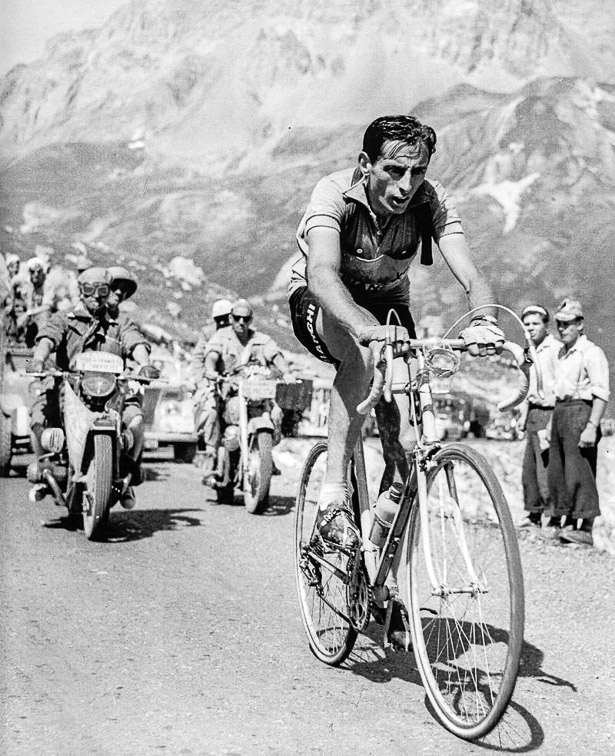
But now, some 40 years later I can see that there was much merit in Mr. Davis’s argument – sorry, Chic!
And if you’re wondering where the roots of this Coppi rant were first nourished, it’s like this…
One of the advantages of writing for various websites – as well as nice trips to the Giro, Tour and Worlds – is that every now and again there are freebees on the go.
Unexpected parcels containing beautiful Castelli clothing, Defeet socks and nice books drop through the letter box at irregular intervals.
And with Christmas rapidly approaching I was recently emailed to ask if I’d like to receive a Hinault, Kuiper, Lemond or Coppi fine bone china mug as a gift.
They were all really nice but there’s something magical about that gorgeous Bianchi ‘celeste’ colour, so that’s what I’ll be drinking my Christmas coffee from – maybe with a shot of grappa in there.
And that got me thinking about the lovely book about Fausto Coppi which Herbie Sykes so kindly gave me to review, way back at the start of the year but which has languished beside my bed ever since.
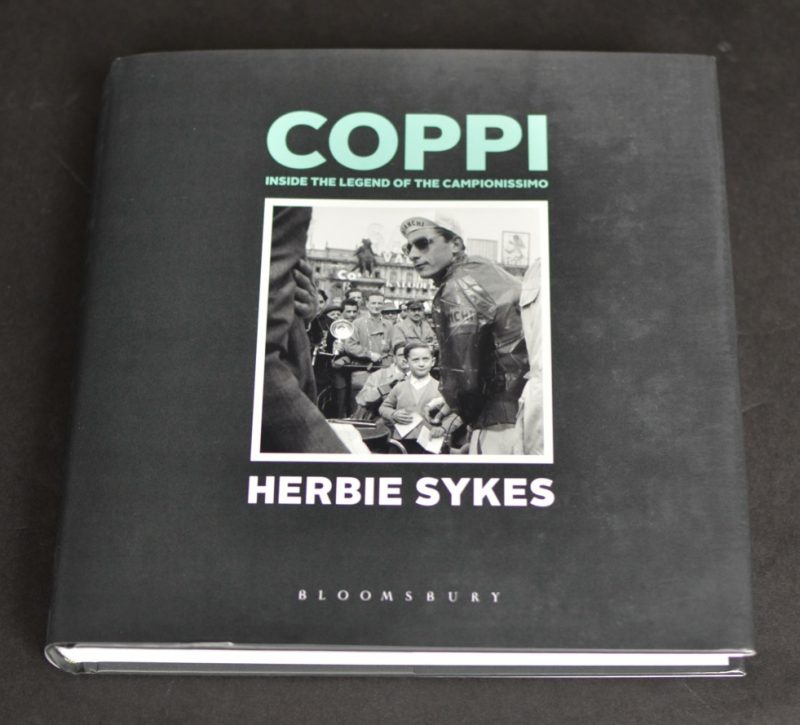
It’s an easy but highly evocative read; the main part of the volume comprises beautiful photographs mined from the vaults of Italian sports photography agencies – with most being seen for the first time.
But the images are interspersed with reminiscences from Coppi’s team mates and contemporaries – with just about every essay containing gems of observation and not a few surprises.
The pictures are wonderful; obviously there are lots of the man on his bike; in common with just about all riders from that era, his machine looks too big for him, accustomed as we are to compact frames and riders like Pozzato and Hesjedal having seat pins like scaffold poles – but that’s just how it was back then.
And the earlier pictures of battle scarred handlebar tape paint with down tube mounted pumps are difficult to take in – but again, that’s how it was in that era.
He was a tall, slim man with long legs and a barrel chest which harboured huge lungs – his five Giro wins then, and two Tour wins then are no surprise but this was a man who could also win Paris-Roubaix, Milan-Sanremo three times, the Tour of Lombardy five times as well as the Grand Prix des Nations twice and take two world titles in the individual pursuit as well as the world road race championship, not to mention the hour record.
These are extraordinary palmares by any standard and for any era.
The action pics I liked best are those of him on the track; riding a madison; in smooth, stylish pursuit mode – and best of all behind a big motor.
But it’s the off the bike shots which are coolest; he was a stylish man – Persol shades, immaculately cut suits, nice knitwear, plaid shirts, camel hair coats and pulling off that difficult trick of getting away with cravats.
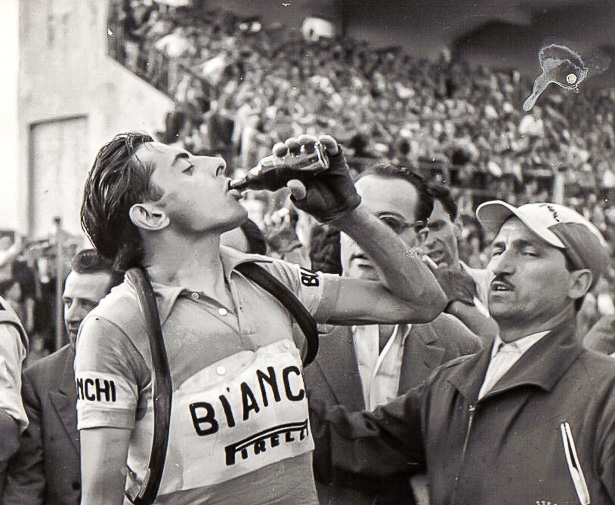
It goes without saying that in his Bianchi and Carpano kit he looked amazing, with track mitts which seem to glow, they’re so white.
There are images of him with his cars; sleek, shining curvaceous Alfa Romeos and Lancias – you’d expect nothing less.
He loved to hunt – a fascination which would ultimately cost him his life – and the pictures from his times with the gun show that even out in the woods his sense of style never left him.
There’s a picture where he wears Converse baseball boots, Argyle socks, plusses, a knitted track top and training cap – looking like he stepped straight out of the pages of Urban Cyclist magazine and decidedly hip.
But with a shotgun in his hand he looks every inch the killer.
He was a killer with the ladies, too – there are pictures of the fair sex gazing adoringly at them and Fausto’s smile in reply says it all.
But his weakness for the ladies would cost him dear.
His affair and subsequent marriage to Giulia Occhini, ‘la dama in bianco’ (woman in white) was to scandalise Italy, cost him a lot of sleepless nights, fans and money.
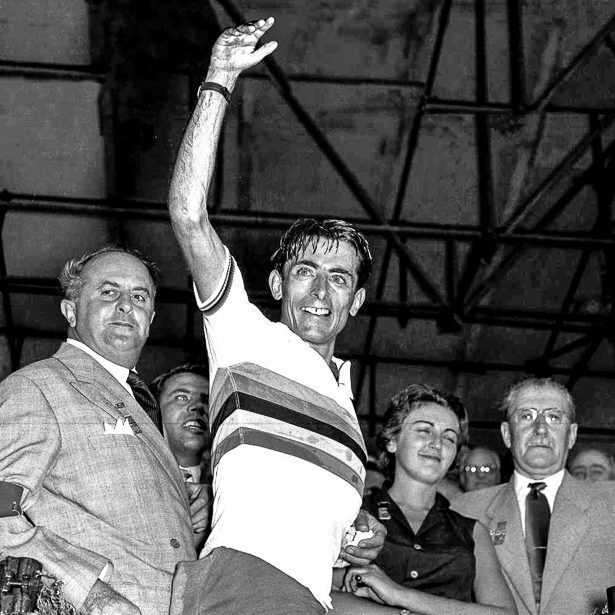
A striking, glamorous woman she was however, ‘not cheap to run’ and her expensive tastes coupled with the alimony he had to pay his ex-wife, Bruna Ciampolini meant that there were several, ‘seasons too many’ – not just one.
The Campionissimo ‘champion of champions’ raced way beyond when he should have been enjoying comfortable retirement, the constant need for start money ensuring there was no dignified end to his career.
That said, his presence could still sell out track meets from Herne Hill to Buenos Aires even when he was well in decline – the fans didn’t just like him, they adored him.
All through the book are pictures where children, women, grown men and even police officers stare with wonder and reverence at him.
His palmares may have been glorious but his life wasn’t all smiles and style.
Apart from the sadness of his decline and the scandal of his adultery with Occhini, he lost his brother and team mate, Serse to a fatal crash in the Giro del Piemonte in 1951 and was cursed with brittle bones; his collar bone (twice), pelvis, shoulder, vertebrae, femur and skull all suffered fractures.
The pictures of him on stretchers and in hospital beds testify to the fact that here was another reason – apart from the war – why his palmares could have been so much broader.
As well as the women and team mates in Coppi’s life there are pictures of Biagio Cavanna, the Svengali-like figure who was the Campionissimo’s mentor, confident and masseur.
The blind ex-boxer was said to have, ‘magic in his hands’ as a masseur; but looks more like a Don from the God Father – it’s unlikely that our Mr. Brailsford would give him a start, magic or no magic.
One of my favourite pictures is the one of Giro pressroom – all suits, ties and Brylcreem and not a laptop or millimetre of trendy stubble in sight.
And then there are the images of post-war Italy; piles of rubble and terrible roads dominate, and whilst reconstruction is going on it’s easy to see that the people needed Coppi – or Bartali – to take their minds off what was a tough life.
Gino Bartali’s image features in the book – he was Coppi’s great rival and unlike the stylish and cavalier Coppi promoted a simple and deeply catholic image, ‘Gino the Pious’ as he was known.
A Giro, Tour and Classics winner he’s now feted as having done remarkable work during World War Two to help Jews escape Nazi persecution.
That said; there are few good words in this book about the man from his contemporaries or team mates.
Not so about Coppi, who seems to have been a man of his word and not prone to singing his own praises, as was the pious one.
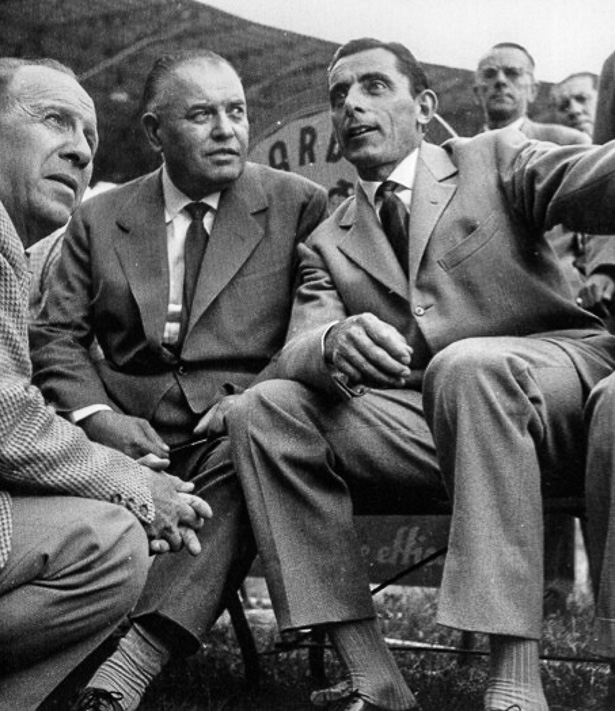
The penultimate images in the book are of a glum looking Coppi on the hunting trip to Burkina Fasso where he would contract the malaria which would take his life.
And finally there’s the funeral, with the pictures – all in washed out colour – showing the mourners in coats and scarves on the cold, snowy hills of Castellania as the Champion of Champions is finally granted peace and an end to the embarrassment of the last days of his career.
A ten out of ten for Mr. Sykes on this one; put it on your list to Mr. Claus – you won’t regret it.



